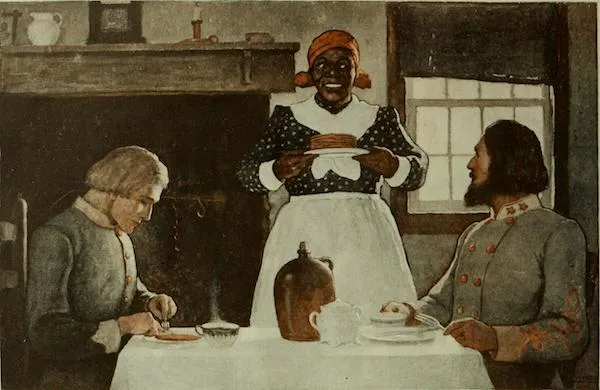
The Gilbert Stuart painting “Portrait of George Washington’s Cook” may depict Hercules, the first president’s eminent chef.
Courtesy of Wikimedia Commons
“We need to forget about this so we can heal,” said an elderly white woman, as she left my lecture on the history of enslaved cooks and their influence on American cuisine. Something I said, or perhaps everything I said, upset her.
My presentation covered 300 years of American history that started with the forced enslavement of millions of Africans, and which still echoes in our culture today, from the myth of the “happy servant” (think Aunt Jemima on the syrup bottle) to the broader marketing of black servitude (as in TV commercials for Caribbean resorts, targeted at white American travelers). I delivered the talk to an audience of 30 at the Maier Museum of Art in Lynchburg, Virginia. While I had not anticipated the woman’s displeasure, trying to forget is not an uncommon response to the unsettling tale of the complicated roots of our history, and particularly some of our beloved foods.
It is the story of people like Chef Hercules, George Washington’s chef; and Emmanuel Jones, who used his skills to transition out of enslavement into a successful career cooking in the food industry, evading the oppressive trappings of sharecropping.* It is also the story of countless unnamed cooks across the South, the details of their existences now lost. But from its most eminent to its anonymous practitioners, the story of Southern cuisine is inseparable from the story of American racism. It’s double-edged—full of pain—but also of pride. Reckoning with it can be cumbersome, but it’s also necessary. The stories of enslaved cooks teach us that we can love our country and also be critical of it, and find some peace along the way.
It’s not effortless uncovering the histories of enslaved cooks, who left few records of their own and whose stories often appear in the historical record as asides—incidental details sprinkled through the stories of the people who held them in bondage. In my recent study of enslaved cooks, I relied on archaeological evidence and material culture—the rooms where they once lived, the ponderous cast iron pots they lugged around, the gardens they planted—and documents such as slaveholders’ letters, cookbooks, and plantation records to learn about their experiences. These remnants, scant though they are, make it clear that enslaved cooks were central players in the birth of our nation’s cultural heritage.
In the early 17th century, tobacco farming began to spread throughout Virginia’s Tidewater region. Before long, plantations were founded by colonists, such as Shirley Plantation, constructed circa 1613; Berkeley Hundred, and Flowerdew Hundred, whose 1,000 acres extended along the James River. These huge homes marked a moment of transition, when English cultural norms took hold on the Virginia landscape.
Traditions surrounding dining and maintaining a grand household were part of those norms, and the white gentry began seeking domestic lend a hand. At first, the cooks they hired on plantations were indentured servants, workers who toiled without pay for a contractually agreed-upon period of time before eventually earning their freedom. But by the tardy 17th century, plantation homes throughout Virginia had turned to enslaved laborers, captured from central and western Africa, to grow crops, build structures and generally remain at the beck and call of white families. Before long these enslaved cooks took the roles that had once been occupied by white indentured servants.
These cooks knew their craft. Hercules, who cooked for George Washington, and James Hemings, an enslaved cook at Thomas Jefferson’s Monticello, were both formally trained, albeit in different styles. Hercules was taught by the well-known New York tavern keeper and culinary giant Samuel Frances, who mentored him in Philadelphia; Hemings traveled with Jefferson to Paris, where he learned French-style cooking. Hercules and Hemings were the nation’s first celebrity chefs, eminent for their talents and skills.
Folklore, archaeological evidence, and a opulent oral tradition reveal that other cooks, their names now lost, also weaved their talents into the fabric of our culinary heritage, creating and normalizing the mixture of European, African, and Native American cuisines that became the staples of Southern food. Enslaved cooks brought this cuisine its unique flavors, adding ingredients such as balmy peppers, peanuts, okra, and greens. They created favorites like gumbo, an adaptation of a conventional West African stew; and jambalaya, a cousin of Jolof rice, a zingy, heavily seasoned rice dish with vegetables and meat. These dishes traveled with captured West Africans on slave ships, and into the kitchens of Virginia’s elite.
For the women who wrote and preserved the receipt books, these recipes, the products of African foodways, were something worthy of remembering, re-creating, and establishing as Americana. So why can’t we, as Americans today, look at this history for what it was? Colonial and antebellum elite Southerners understood fully that enslaved people cooked their food. During the 19th century, there were moments of widespread fear that these cooks would poison them, and we know from court records and other documents that on at least a few occasions enslaved cooks did slip poisons like hemlock into their masters’ food.

Depiction of Aunt Jemima, 1920, in the Saturday Evening Post
Courtesy of Internet Archive Book Images, via Wikimedia Commons
But the country began recalibrating its memories of black cooking even before the Civil War, erasing the brutality and hardships of slavery from a story of Old Southern graciousness. The revisionism went full throttle during the era of Jim Crow, when modern laws made segregation the norm. Post-emancipation America still relied heavily on the skills and labor of newly freed African Americans. In a highly racialized and segregated America, still grappling with its guilt over slavery, white people created a myth that these cooks were—and always had been—joyful. Advertisers leaned on characters like Aunt Jemima and Rastus, stereotypical black domestics, drawn from minstrel song.
While newly free African Americans fled the plantations to find work as housekeepers, butlers, cooks, drivers, Pullman porters and waiters—the only jobs they could get—Aunt Jemima and Rastus smiled while serving white folks, enhancing the myth that black cooks had always been cheerful and satisfied, during slavery and with their current situation. You can find their faces throughout early 20th-century black Americana, and they are still on the grocery shelves today, though modified to reflect a more dignified image.
My irate audience member was likely raised on the venerable enslaved-cook narrative in which these images took root, where the cook was devoted, passive, and purportedly joyful—a non-threatening being whose ultimate goal was to lend a hand a white woman fulfill her own domestic vision. But to be an American is to live in a place where contradictions are the very fibers that bind a complicated heritage divided sharply by race. It is to ignore the story of Chef Hercules, or the real story of Aunt Jemima. By forgetting enslaved cooks’ pain to soothe our own, we erase the pride and the achievements of countless brilliant cooks who nourished a nation.
Get the latest History stories in your inbox?
Filed Under:
African American History,
American History,
Food,
Food History,
Rituals and Traditions

